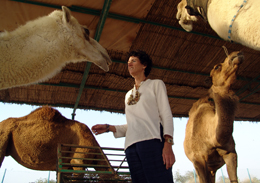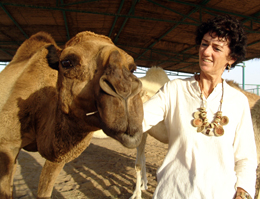The Camel Lady of Dubai |
 |
<<Click to see original |
She is widely known as the camel lady, but Lilianne Donders has a huge following right across the Middle East and beyond. She is renowned not just for her extensive charity work, but especially for her love of camels; and sadly Dubai will shortly have to say goodbye to this amazing woman as she leaves the UAE to settle down in Oman.

Lilianne was born in the Netherlands, trained to be a registered nurse and studied to become a fashion designer, graduating as an Instructor in 1979. Following her marriage to Robert, his work in an oil company saw them posted to the Sultanate of Oman, a move for the two of them that changed their lives forever. Now some three decades later Lilianne has covered thousands of miles travelling on foot through some of the remotest parts of Arabia.
Lilianne lived for eight years in Oman, getting to know the locals, with whom she struck up intense friendships. “It was at a souq in the interior of the country that I met some Bedu women whom I got to meet regularly,” she tells me. “Six months later they said they wanted to adopt me – literally – as part of their family. The ritual was carried out in a mosque and I was given the name Leila Al Jenaibah; and at that moment I officially became part of their tribe," she explains in a matter of fact way, as if this were quite a normal thing to happen to any European woman, though she is the first to acknowledge that she was extremely honoured to be accepted in this way by her new Bedu family.
From those first encounters with the Bedouin of Oman, Lilianne became fascinated by their nomadic life style and developed an especial fondness for their main means of transport – Attah Allah – God’s gift – the camel.

In 1988 her husband was transferred to Syria, which became their new home for nearly three years before they had to move away from the Middle East – first to Norway and then to London. But by 1997 they were back once again in Syria where Lilianne wasted no time in going out to buy her very first camels. From Damascus she travelled with an Arab friend to Duma, an area 10kms to the north where camels are slaughtered for meat. “We went to a farm where there were some very sad camels – some with broken legs; horrific injuries. But there was a brown one standing in the middle looking really proud, which I really liked. She had a little baby – a little hump on the floor. So we made the negotiations and I bought them. I called them Zubeida and Sheba.”
Her second pair of camels was sold to her by a local sheikh in Palmyra. They were offered for sale along with six others. But while Lilianne had a difficult time choosing which to purchase, a pure white one - Zenobia - made the choice for her. She laid her head in Lilianne’s arms, and from that moment on there was no contest!
By now a long-held wish to walk along the ancient camel caravan routes became a distinct possibility for Lilianne; but while preparing for her first caravan she was diagnosed with breast cancer. And as if this wasn’t enough of an ordeal, her husband was told that they would have to move to their next posting in Tehran, right in the middle of her radiation and chemo-therapy treatment. Most rational people might at this stage have decided to call the whole trip off. Lilianne, on the other hand, decided instead to extend her walk from Damascus all the way to Tehran – some 3,000 kms. The walk would be sponsored and the proceeds would go to establishing a clinic for Bedu women living in the desert areas around Palmyra in Syria.
The ‘Caravan for Cancer’ raised over US $35,000 which paid for a Well Woman clinic run by the Syrian Arab Red Crescent Society, to which any woman with medical problems can be referred.
In 2004 Lilianne decided to repeat the experience when her husband was posted to the UAE. She would walk this time from Tehran to Dubai, but also take in Muscat on the circuitous route. This voyage, which took seven months, became the “Caravan of Hope” with sponsorship proceeds being dedicated to building a mother and child clinic for Palestinian refugees.
Lilianne freely admits that she knew next to nothing about camels when first she started to keep them. Today she is an expert and regularly passes on her extensive knowledge to other camel owners. This knowledge has been acquired under some extraordinary circumstances. Zubeida, for instance, had a chronic ear infection which made her very difficult to handle. No-one knew what the problem was, so Lilianne went to the local butcher, bought the head of a dead camel and, using a scalpel, dissected the head to understand how the camel’s aural system worked. She also discovered by trial and error that camels respond well to the use of the homeopathic medicine arnica – but at very much higher doses than is normally given to humans.
A whole book could be written about Lilianne’s adventures in Arabia; and an equally long tome could be put together along the lines of An Idiot’s Guide to Keeping Camels. But one thing is for sure: with the firm friendships that have grown up between Lilianne and her much extended families throughout the Middle East, it surely can’t be long before we see her with her troupe of camels in the UAE once again.
